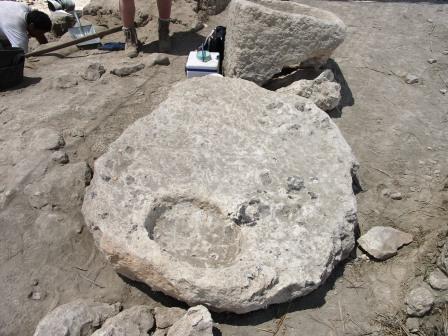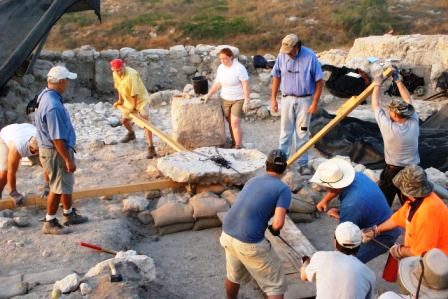by John Strong
June 23, 2011
To repeat myself from my last entry, archaeology is the careful practice of destruction. Today, it is not the removal of an ancient wall that we are focused on, but rather the removal of an impressive olive oil production installation. The reader may recall from my previous entry that the “pillar” (L52026, according to our records) was first an olive oil vat. It was used in conjunction with a very impressive stone that had a small collection vat carved into it. We often see these outside of cities, out in the fields where olives were harvested, and where these types of bins can be carved into the bedrock, but it is rare to see one inside a city because cities generally do not have exposed bedrock, and to move such a heavy stone into just the right place is a feat—as we ourselves learned by experience.

Our job, as it turned out was not to place this installation (L41036, according to our records), but to move it out so that we could explore underneath it in order to understand it and its use. Now the ancient Gezerites were not stupid (the jury is still out in regard to the intelligence of modern archaeologists!). They knew what a royal pain it was to place, so when their olive oil operation was no longer needed, they just left it in place and built over it. So, for about 2800 years, it has sat silent in the dirt, not troubling a soul—until we excavated it in 2009.
Because to understand which walls and surfaces this installation went with, and to date it by the pottery found underneath it, we needed to remove it. In addition, we needed to explore the strata of earlier occupations of Gezer below our beloved installation, L41036. I can only imagine that the ancient occupants moved this 2,000 pound stone much more gracefully than we did, if for no other reason than they had slaves and did not worry too much about who got injured in the process. We were worried about our volunteers, actually, so the engineering of this was a little tricky.

Our solution: Attach a few ropes to it, enlist about a dozen large, hefty volunteers, get a few others using levers, get some wood under it to act as skids, and heave, heave, heave. And, sure enough, we were able to move it about 30 feet—just far enough to park it in an unused part of the excavation, where it will await a crane that will load it on to a truck and move it to a storeroom of the Israeli Antiquities Authority.
And with this effort, we destroyed what the ancient Gezerites just covered over—their outmoded oil operation. And with this destruction, our discoveries continued.

